Twitch continues to dominate live streaming with its second-biggest quarter to date
Twitch continues to lead rivals including, YouTube Live, Facebook Gaming and Microsoft’s Mixer, when it comes to live-streaming video. Despite experiencing its first decline in hours watched in Q2 2019, the Amazon-owned game-streaming site still had its second-biggest quarter to date, with more than 70% of the hours watched during the quarter.
According to a new report from StreamElements, Twitch viewers live-streamed a total of 2.72+ billion hours in Q2 — or 72.2% of all live hours watched — compared with 735.54 million hours on YouTube Live (19.5%), 197.76 million on Facebook Gaming (5.3%) and just 112.29 million hours (3%) on Mixer.
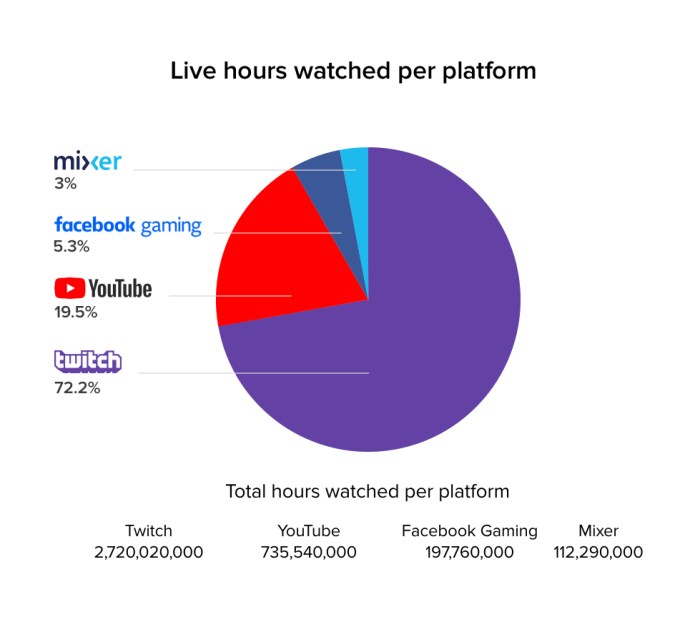
Combined, the total hours watched across all four platforms was 3.77 billion in Q2.
While none of Twitch’s rivals are nearly catching up, YouTube Live did have a good month in May, breaking its own record with 284 million hours watched. Overall, YouTube Live’s hours watched improved in Q2 as a result, while Twitch saw a slight decline.
Facebook Gaming is also gaining steam. It’s now the third-biggest live-streaming platform, having passed Microsoft Mixer.

Despite its traction, Twitch doesn’t have much of a long tail when it comes to stream viewership. That’s a problem it has faced for some time, as newcomers complained they spent years broadcasting to no one in hopes of gaining a fan base, with little success. Twitch has tried to remedy this problem with various educational efforts as well as product features like Raids and Squad Streams, for example.
However, the new report finds that the majority (almost 75%) of Twitch’s viewership still comes from people tuning in to the top 5,000 channels. Out of the 2.7 billion hours watched in Q2, these top 5,000 channels drove 2 billion of those hours watched.
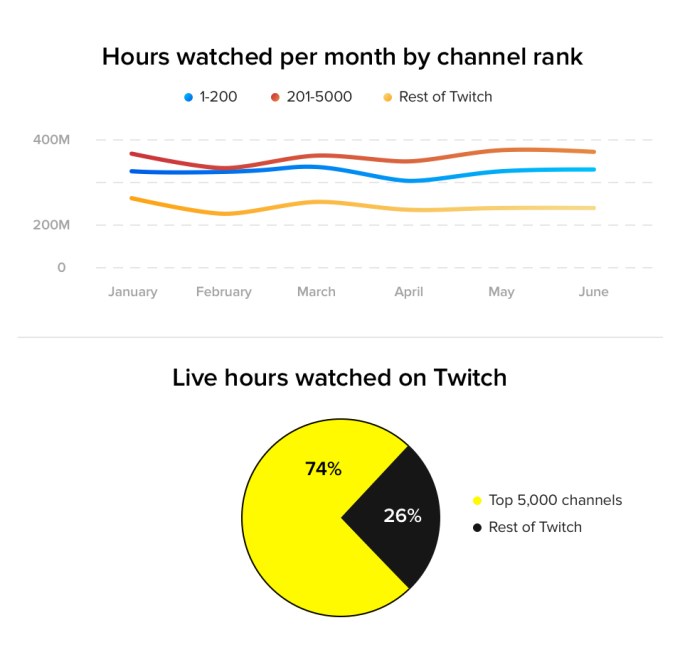
In addition, the average concurrent viewership (viewers watching at the same time) of the top 5,000 channels increased by 12% in Q2 2019, compared with Q1. The top 200 channels have the highest concurrent viewership with 10,590 people watching together, on average.
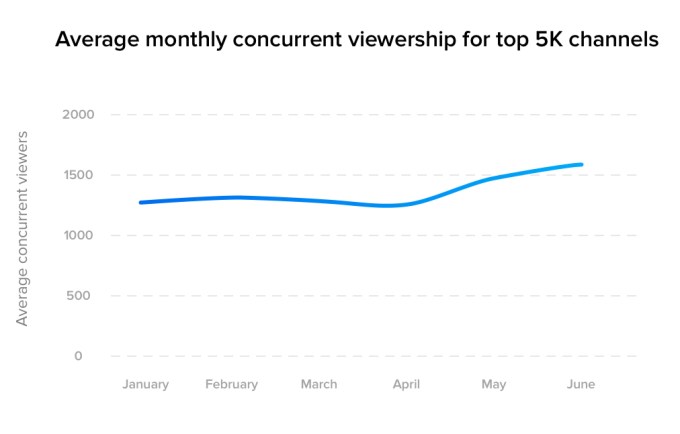
Also in the quarter, viewership of top titles like Fortnite, League of Legends, Dota 2 and Counter-Strike: Global Offensive declined, while vlogging — aka “Just Chatting” — grew, along with other titles.
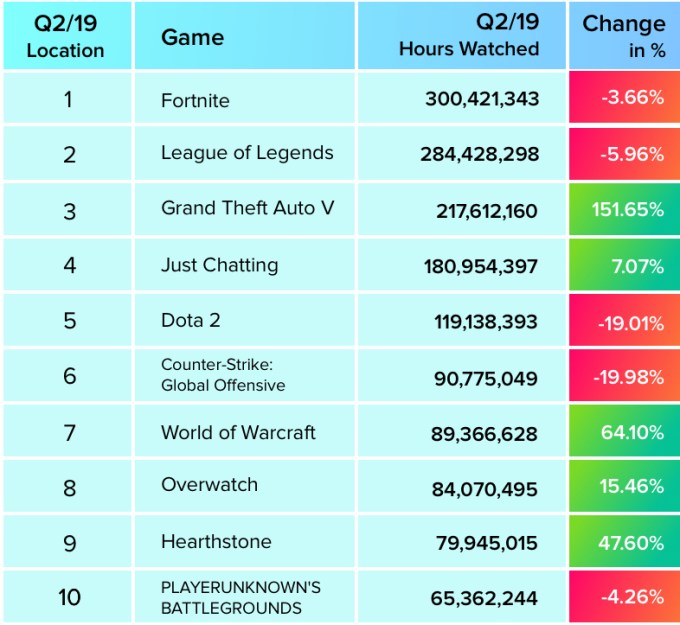
Esports, meanwhile, still draws big numbers, but represents only a small slice of the overall pie.
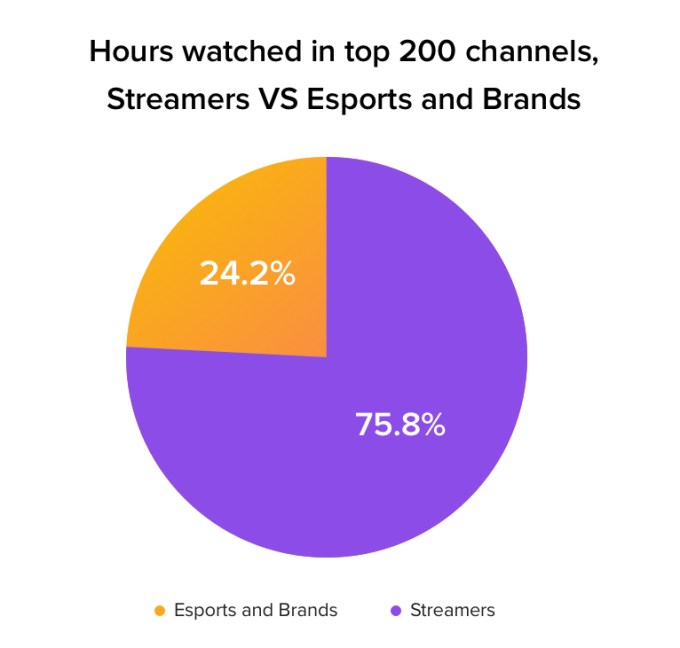
The full report, which takes a look at other trends, including which streamers are gaining and losing popularity, is available here.
Powered by WPeMatico
Digging into the Roblox growth strategy
Could Roblox create a new entertainment and communication category, something it calls “human co-experience”?
When it was a small startup, few observers would have believed in that future. But after 15 years — as told in the origin story of our Roblox EC-1 — the company has accumulated 90 million users and a new $150 million venture funding war chest. It has captured the imagination of America’s youth, and become a startup darling in the entertainment space.
But what, exactly, is human co-experience? Well, it can’t be described precisely — because it’s still an emerging category. “It’s almost like that fable where the nine blind men are touching and describing an elephant.
Everyone has a slightly different view,” says co-founder and CEO Dave Baszucki. In Roblox’s view, co-experience means immersive environments where users play, explore, talk, hang out, and create an identity that’s as thoroughly fleshed out (if not as fleshy) as their offline, real life.
But the next decade at Roblox will also be its most challenging time yet, as it seeks to expand from 90 million users to, potentially, a billion or more. To do so, it needs to pull off two coups.
First, it needs to expand the age range of its players beyond its current tween and teen audience. Second, it must win the international market. Accomplishing both of these will be a puzzle with many moving parts.
What Roblox is today
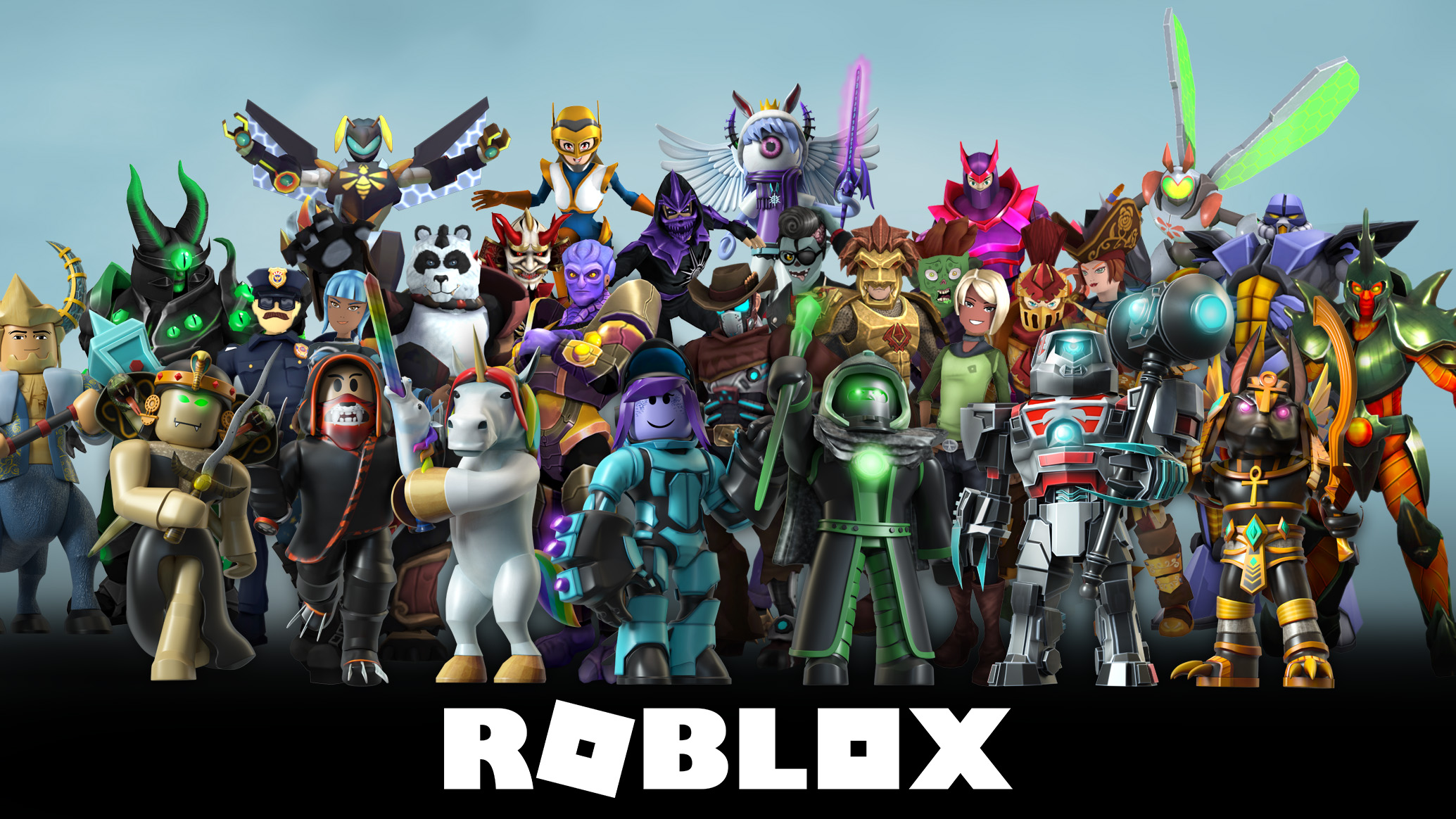
One thing Roblox has done very well is appeal to kids within a certain age range. The company says that a majority of all 9-to-12-year-old children in the United States are on its platform.
Within that youthful segment, Roblox has arguably already created the human co-experience category. Many games are more cooperative than competitive, or have goals that are unclear or don’t seem to matter much. One of Roblox’s most popular games, for instance, is MeepCity, where players can run around and chat in virtual environments like a high school without necessarily interacting with the game mechanics at all.
What else separates these environments from what you can see today on, say, the App Store or Steam? A few characteristics seem common.
For one, the environments look rough. One Robloxian put the company’s relaxed attitude toward looks as “not over-indexing on visual fidelity.”
Roblox games also ignore the design principles now espoused by nearly every game company. Tutorials are infrequent, user interfaces are unpolished, and one gets the sense that KPIs like retention and engagement are not being carefully measured.
That’s similar to how games on platforms like Facebook and the App Store started out, so it seems reasonable to say Roblox is just in a similarly early stage. It is — but it’s also competing directly with mobile games that are more rigorously designed. Over half of its players are on smartphones, where they could have chosen a free game that looks more polished, like Fortnite or Clash of Clans.
The more accurate explanation of why Roblox draws big player numbers is that there’s a gap in the kids entertainment market. So far, only Roblox fills that gap, despite its various shortcomings.
“The amount of unstructured, undirected play has been declining for decades. [Kids] have much more homework, and structured activities like theater after school.
One of the big unmet needs we solve is to give kids a place to have imagination,” explains Craig Donato, Roblox’s chief business officer. “If you play the experiences on our platform, you’re not playing to win. You go into these worlds with people you know and share an experience.”
Games like The Sims tried to do the same, but eventually faded in the children’s demo. Roblox’s trick has been continued growth: it provides kids with an endless array of games that unlock their imagination. But just like we don’t expect adults to have fun with Barbie dolls, it’s unlikely most adults would enjoy Roblox games.
Of course, it would be easy to point at Roblox and laugh off its ambitions to win over people of all ages. That laughter would also be short-sighted.
As David Sze, the Greylock Partners investor who led Roblox’s most recent round, pointed out: “When we invested in Facebook there was a huge amount of pushback that nobody would use it outside college.” Companies that have won over one demographic have a good chance of winning others.
Roblox has also proven its ability to evolve. At one time, the platform’s players were 90 percent male. Now, that’s down to about 60 percent. Roblox now has far more girls playing than the typical game platform.
Evolving to new demographics
Powered by WPeMatico
Judge dismisses Oracle lawsuit over $10B Pentagon JEDI cloud contract
Oracle has been complaining about the procurement process around the Pentagon’s $10 billion, decade-long JEDI cloud contract, even before the DoD opened requests for proposals last year. It went so far as to file a lawsuit in December, claiming a potential conflict of interest on the part of a procurement team member. Today, that case was dismissed in federal court.
In dismissing the case, Federal Claims Court Senior Judge Eric Bruggink ruled that the company had failed to prove a conflict in the procurement process, something the DOD’s own internal audits found in two separate investigations. Judge Bruggink ultimately agreed with the DoD’s findings:
We conclude as well that the contracting officer’s findings that an organizational conflict of interest does not exist and that individual conflicts of interest did not impact the procurement, were not arbitrary, capricious, an abuse of discretion, or otherwise not in accordance with law. Plaintiff’s motion for judgment on the administrative record is therefore denied.
The company previously had filed a failed protest with the Government Accountability Office (GAO), which also ruled that the procurement process was fair and didn’t favor any particular vendor. Oracle had claimed that the process was designed to favor cloud market leader AWS.
It’s worth noting that the employee in question was a former AWS employee. AWS joined the lawsuit as part of the legal process, stating at the time in the legal motion, “Oracle’s Complaint specifically alleges conflicts of interest involving AWS. Thus, AWS has direct and substantial economic interests at stake in this case, and its disposition clearly could impair those interests.”
Today’s ruling opens the door for the announcement of a winner of the $10 billion contract, as early as next month. The DoD previously announced that it had chosen Microsoft and Amazon as the two finalists for the winner-take-all bid.
Powered by WPeMatico
With $34B Red Hat deal closed, IBM needs to execute now
In a summer surprise this week, IBM announced it had closed its $34 billion blockbuster deal to acquire Red Hat. The deal, which was announced in October, was expected to take a year to clear all of the regulatory hurdles, but U.S. and EU regulators moved surprisingly quickly. For IBM, the future starts now, and it needs to find a way to ensure that this works.
There are always going to be layers of complexity in a deal of this scope, as IBM moves to incorporate Red Hat into its product family quickly and get the company moving. It’s never easy combining two large organizations, but with IBM mired in single-digit cloud market share and years of sluggish growth, it is hoping that Red Hat will give it a strong hybrid cloud story that can help begin to alter its recent fortunes.
As Box CEO (and IBM partner) Aaron Levie tweeted at the time the deal was announced, “Transformation requires big bets, and this is a good one.” While the deal is very much about transformation, we won’t know for some time if it’s a good one.
Transformation blues
Powered by WPeMatico
Negative? How a Navy veteran refused to accept a ‘no’ to his battery invention
Decades ago, a young naval engineer on a British nuclear submarine started taking an interest in the electric batteries helping to run his vessel. Silently running under the frozen polar ice cap during the Cold War, little did this submariner know that, in the 21st century, batteries would become one of the biggest single sectors in technology. Even the planet. But his curiosity stayed with him, and almost 20 years ago he decided to pursue that dream, born many years beneath the waves.
The journey for Trevor Jackson started, as many things do in tech, with research. He’d become fascinated by the experiments done not with lithium batteries, which had come to dominate the battery industry, but with so-called “aluminum-air” batteries.
Technically described as “(Al)/air” batteries, these are the — almost — untold story from the battery world. For starters, an aluminum-air battery system can generate enough energy and power for driving ranges and acceleration similar to gasoline-powered cars.
Sometimes known as “Metal-Air” batteries, these have been successfully used in “off-grid” applications for many years, just as batteries powering army radios. The most attractive metal in this type of battery is aluminum because it is the most common metal on Earth and has one of the highest energy densities.
Think of an air-breathing battery which uses aluminum as a “fuel.” That means it can provide vehicle power with energy originating from clean sources (hydro, geothermal, nuclear etc.). These are the power sources for most aluminum smelters all over the world. The only waste product is aluminum hydroxide and this can be returned to the smelter as the feedstock for — guess what? — making more aluminum! This cycle is therefore highly sustainable and separate from the oil industry. You could even recycle aluminum cans and use them to make batteries.
Imagine that — a power source separate from the highly polluting oil industry.
But hardly anyone was using them in mainstream applications. Why?

Aluminum-air batteries had been around for a while. But the problem with a battery which generated electricity by “eating” aluminum was that it was simply not efficient. The electrolyte used just didn’t work well.
This was important. An electrolyte is a chemical medium inside a battery that allows the flow of electrical charge between the cathode and anode. When a device is connected to a battery — a light bulb or an electric circuit — chemical reactions occur on the electrodes that create a flow of electrical energy to the device.
When an aluminum-air battery starts to run, a chemical reaction produces a “gel” by-product which can gradually block the airways into the cell. It seemed like an intractable problem for researchers to deal with.
But after a lot of experimentation, in 2001, Jackson developed what he believed to be a revolutionary kind of electrolyte for aluminum-air batteries which had the potential to remove the barriers to commercialization. His specially developed electrolyte did not produce the hated gel that would destroy the efficiency of an aluminum-air battery. It seemed like a game-changer.
The breakthrough — if proven — had huge potential. The energy density of his battery was about eight times that of a lithium-ion battery. He was incredibly excited. Then he tried to tell politicians…

Despite a detailed demonstration of a working battery to Lord “Jim” Knight in 2001, followed by email correspondence and a promise to “pass it onto Tony (Blair),” there was no interest from the U.K. government.
And Jackson faced bureaucratic hurdles. The U.K. government’s official innovation body, Innovate UK, emphasized lithium battery technology, not aluminum-air batteries.
He was struggling to convince public and private investors to back him, such was the hold the “lithium battery lobby” had over the sector.
This emphasis on lithium batteries over anything else meant U.K. the government was effectively leaving on the table a technology which could revolutionize electrical storage and mobility and even contribute to the fight against carbon emission and move the U.K. toward its pollution-reduction goals.
Disappointed in the U.K., Jackson upped sticks and found better backing in France, where he moved his R&D in 2005.
Finally, in 2007, the potential of Jackson’s invention was confirmed independently in France at the Polytech Nantes institution. Its advantages over Lithium Ion batteries were (and still are) increased cell voltage. They used ordinary aluminum, would create very little pollution and had a steady, long-duration power output.
As a result, in 2007 the French Government formally endorsed the technology as “strategic and in the national interest of France.”
At this point, the U.K.’s Foreign Office suddenly woke up and took notice.
It promised Jackson that the UKTI would deliver “300%” effort in launching the technology in the U.K. if it was “repatriated” back to the U.K.
However, in 2009, the U.K.’s Technology Strategy Board refused to back the technology, citing that the Automotive Council Technology Road Map “excluded this type of battery.” Even though the Carbon Trust agreed that it did indeed constitute a “credible CO2-reduction technology,” it refused to assist Jackson further.
Meanwhile, other governments were more enthusiastic about exploring metal-air batteries.
The Israeli government, for instance, directly invested in Phinergy, a startup working on very similar aluminum-air technology. Here’s an, admittedly corporate, video which actually shows the advantages of metal-air batteries in electric cars:
The Russian Aluminum company RUSAL developed a CO2-free smelting process, meaning they could, in theory, make an aluminum-air battery with a CO2-free process.
Jackson tried to tell the U.K. government they were making a mistake. Appearing before the Parliamentary Select Committee for business-energy and industrial strategy, he described how the U.K. had created a bias toward lithium-ion technology which had led to a battery-tech ecosystem which was funding lithium-ion research to the tune of billions of pounds. In 2017, Prime Minister Theresa May further backed the lithium-ion industry.
Jackson (below) refused to take no for an answer.

He applied to U.K.’s Defence Science and Technology Laboratory. But in 2017 they replied with a “no-fund” decision which dismissed the technology, even though DSTL had an actual programme of its own on aluminum-air technology, dedicated to finding a better electrolyte, at Southampton University.
Jackson turned to the auto industry instead. He formed his company MAL (branded as “Metalectrique“) in 2013 and used seed funding to successfully test a long-range design of power pack in its laboratory facilities in Tavistock, U.K.
Here he is on a regional BBC channel explaining the battery:
He worked closely with Lotus Engineering to design and develop long-range replacement power packs for the Nissan Leaf and the Mahindra Reva “G-Wiz’ electric cars. At the time, Nissan expressed a strong interest in this “Beyond Lithium Technology” (their words) but they were already committed to fitting LiON batteries to the Leaf. Undeterred, Jackson concentrated on the G-Wiz and went on to produce full-size battery cells for testing and showed that aluminum-air technology was superior to any other existing technology.
And now this emphasis on lithium-ion is still holding back the industry.
The fact is that lithium batteries now face considerable challenges. The technology development has peaked; unlike aluminum, lithium is not recyclable and lithium battery supplies are not assured.
The advantages of aluminum-air technology are numerous. Without having to charge the battery, a car could simply swap out the battery in seconds, completely removing “charge time.” Most current charging points are rated at 50 kW which is roughly one-hundredth of that required to charge a lithium battery in five minutes. Meanwhile, hydrogen fuel cells would require a huge and expensive hydrogen distribution infrastructure and a new hydrogen generation system.
But Jackson has kept on pushing, convinced his technology can address both the power needs of the future, and the climate crisis.
Last May, he started getting much-needed recognition.
The U.K.’s Advanced Propulsion Centre included the Metalectrique battery as part of its grant investment into 15 U.K. startups to take their technology to the next level as part of its Technology Developer Accelerator Programme (TDAP). The TDAP is part of a 10-year program to make U.K. a world-leader in low-carbon propulsion technology.
The catch? These 15 companies have to share a paltry £1.1 million in funding.
And as for Jackson? He’s still raising money for Metalectrique and spreading the word about the potential for aluminum-air batteries to save the planet.
Heaven knows, at this point, it could use it.
Powered by WPeMatico
When someone great is gone: How to address grief in the workplace with empathy
Birthday cakes, gift cards, free lunches, snacks, movie tickets, and other perks are generously bestowed on employees to celebrate life’s happy moments. This is an improvement from the industrial approach to management, but can we go deeper for our work-family members?
Life’s darker moments hold the greatest opportunity to exemplify a genuine and caring 21st-century workplace culture. One which fosters empathy and camaraderie. Employee turnover is highest when employees take leave, claim FMLA, or use PTO. According to Global Studies, 79% of employees report their reason for quitting was simply due to feeling unnoticed (lack of appreciation).
Appreciation for your employees is best demonstrated as an act of kindness in moments that really matter, like the loss of a family member. Acknowledging that someone great is gone, instead of ignoring the uncomfortable aspects of grief, is a valuable way to embed empathy into your workplace culture.
Recently, while working with a mid-sized (500+ employees) tech company, I asked what they were doing to support employees during the negative life moments. The HR Director replied, “um, nothing really”.
Once realizing how crappy that sounded, another executive countered her by saying he sent an employee a t-shirt and card after a miscarriage. I later learned that the employee he was referring to had been with the company for over 5 years, so it’s safe to assume that she had a couple of company swag t-shirts in her collection prior to getting one as a get well gift.
Even in the largest and most notable companies, where a variety of employee amenities and benefits are offered, the concept and practice of empathy is often neglected. Perhaps you haven’t come across such extreme examples of indifference in your workplace, but you may have participated in signing a generic condolences card or chipping in for some flowers.
Powered by WPeMatico
Verified Expert Brand Designer: Studio Rodrigo
Ritik Dholakia worked as a startup product manager before he co-founded Studio Rodrigo, a branding and product design agency based in NYC. Unlike traditional branding firms, Studio Rodrigo is proud of its product design chops, especially when it comes to helping early-stage startups build version one of their product. It’s not an easy balancing act since most companies eventually want to bring their product design talent in-house, but it turns out, Studio Rodrigo can help with that too. Learn more about the studio in our Q&A with founder Ritik Dholakia.
Studio Rodrigo’s unique approach:
“Studio Rodrigo listened to all of our goals and dreams, concerns and uncertainties, and created a brand identity, website, and marketing materials that were true to our vision but better than anything we could have imagined.” Tze Chun, NYC, Founder, Uprise Art
“Basically, we’re a full-stack product design team. We have people who can do brand identity from a pure graphic design and visual communications standpoint, and who can also connect the dots between design and technology, business, and customer needs. We don’t have a traditional agency model with a project and account management overhead. You work directly with our designers.”
On Studio Rodrigo’s ideal client:
“We like working with clients that are solving big, meaty, challenging problems. We’ve got a smart team that likes to wrap their heads around the kinds of technologies that are pushing industries forward. For us, that’s currently technologies like machine learning and artificial intelligence.”
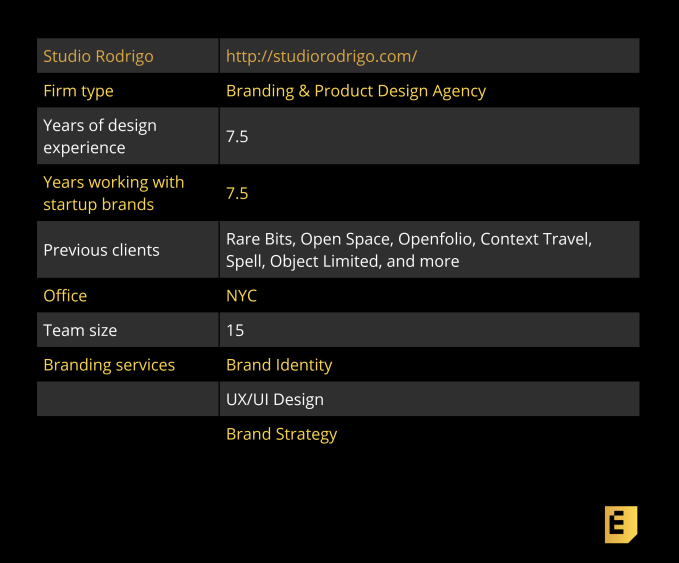
Below, you’ll find the rest of the founder reviews, the full interview, and more details like pricing and fee structures. This profile is part of our ongoing series covering startup brand designers and agencies with whom founders love to work, based on this survey and our own research. The survey is open indefinitely, so please fill it out if you haven’t already.
Interview with Studio Rodrigo Co-founder Ritik Dholakia

Yvonne Leow: First things first, how did you get into brand design and product development?
Ritik Dholakia: I’ve been in digital design and product development for about 20 years now. I actually started my career as a product manager at a startup. I worked for two venture-backed startups as the first product manager. I was part of the Series A team, managing product development, acquiring initial customers, and building market traction.
The first startup was an enterprise software platform for customers doing triple bottom line reporting. The second one was one of the earliest social networking platforms, pre-Facebook, and around the same time as Friendster, LinkedIn, and Spoke.
Powered by WPeMatico
Facebook answers how Libra taxes & anti-fraud will work
Facebook provided TechCrunch with new information on how its cryptocurrency will stay legal amidst allegations from President Trump that Libra could facilitate “unlawful behavior.” Facebook and Libra Association executives tell me they expect Libra will incur sales tax and capital gains taxes. They confirmed that Facebook is also in talks with local convenience stores and money exchanges to ensure anti-laundering checks are applied when people cash-in or cash-out Libra for traditional currency, and to let you use a QR code to buy or sell Libra in person.
A Facebook spokesperson said the company wouldn’t respond directly to Trump’s tweets, but noted that the Libra association won’t interact with consumers or operate as a bank, and that Libra is meant to be a complement to the existing financial system.
Trump had tweeted that “Unregulated Crypto Assets can facilitate unlawful behavior, including drug trade and other illegal activity. Similarly, Facebook Libra’s ‘virtual currency’ will have little standing or dependability. If Facebook and other companies want to become a bank, they must seek a new Banking Charter and become subject to all Banking Regulations, just like other Banks, both National and International.”
For a primer on how Libra works, watch our explainer video below or read our deep dive into everything you need to know:
In a wide-reaching series of interviews this week, the Libra Association’s head of policy Dante Disparte, Facebook’s head economist for blockchain Christian Catalini and Facebook’s blockchain project subsidiary Calibra’s VP of product Kevin Weil answered questions about regulation of Libra. Here’s what we’ve learned (their answers were trimmed for clarity but not edited):
Would Facebook’s Calibra Wallet launch elsewhere even if it’s banned in the USA by regulators?
Calibra’s Kevin Weil: We believe that creating a financial ecosystem that has significantly broader access where all it takes is a phone and lower transaction fees across the board is good for people. And we want to bring it to as many people around the world as we can. But as a custodial wallet we are regulated and will be compliant and we will only operate in markets where we’re allowed.
We want that to be as many markets as possible. That’s why we announced well in advance of actually launching a product — because we’ve been engaging with regulators. We’re continuing to engage with regulators and we can help them understand the effort that we’re taking to make sure that people are safe and also the value that accrues to the people in their countries when there’s broader access to financial services with lower transaction fees across the board.

TechCrunch: But what if you’re banned in the U.S.?
Weil: I’m hesitant to give a blanket answer. But in general, we believe that Libra is positive for people and we want to launch as broadly as possible. The world where the U.S. does that I think would probably cause other regulatory regimes to also be concerned about it. I think that’s very much a bridge that we’ll cross when we get there. But so far we’re having frank, open and honest discussions with regulators. Obviously, that continues next week with David’s testimony. And I hope it doesn’t come to that, because I think that Libra can do a lot of good for a lot of people.
TechCrunch’s Analysis: The U.S. House subcommittee has already submitted a letter to Facebook requesting that it cease development of Libra and Calibra until regulators can better examine it and take action. It sounds like Facebook believes a U.S. ban on Libra/Calibra would cause a domino effect in other top markets, and therefore make it tough to rationalize still launching. That puts even more pressure on the outcome of July 16th and 17th’s congressional hearings on Libra with the head of Facebook’s head of Calibra, David Marcus.
How will users cash-in and cash-out of Libra in person?
We already know that Facebook’s own Libra wallet called Calibra will be baked into Messenger and WhatsApp plus have its own standalone app. There, those with connected bank accounts and government ID that go through a Know Your Customer (KYC) anti-fraud/laundering check will be able to buy and sell Libra. But a big goal of Libra is to bring the unbanked into the modern financial system. How does that work?
Weil: Because Libra is an open ecosystem, any money exchange business or entrepreneur can begin supporting cash-in/cash-out without needing any permission from anyone associated with the Libra Association or member of the Libra Association. They can just do it. Today in a lot of emerging markets [there’s a service for matching you with someone to exchange cryptocurrency for cash or vice-versa called] LocalBitcoins.com and I think you’ll see that with Libra too.
Second, we can augment that by by working with local exchanges, convenience stores and other cash-in/cash-out providers to make it easy from within Calibra. You could imagine an experience in the Calibra app or within Messenger or WhatsApp, where if you want to cash in or cash out, you’ll pop up a map that highlights physical locations around that allow you to do it. You select one that’s nearby, you select an amount, and you get a QR code that you can take to them and complete the transaction.
I’d imagine that most of these businesses that we work with will support Libra more broadly, so even if we get these deals started it will benefit the whole ecosystem and every Libra wallet, not just Calibra.

TechCrunch: Have you struck relationships with any convenience store operators or money exchangers like Western Union or MoneyGram, or Walgreens, CVS or 7-Eleven? Are you in talks with them yet?
Weil: I probably shouldn’t comment on any specific deals but we’re in conversation with a lot of the folks you might think, because ultimately being able to move between Libra and your local currency is critical to driving adoption and utility in the early days . . . If you’re banked there are easier ways to do that. If you’re not banked and you’re in cash — those are the people we really want to serve with Libra — we’re working very hard to make that process easy for people.
TechCrunch’s analysis: This approach will let Calibra largely avoid the complicated and potentially error-prone process of KYCing people in person or handing out cash by offloading the responsibility and liability to other parties.
How will Libra stop fraud or laundering while offering access to unbanked users without ID?
Weil: There are very important populations that don’t have an ID. People in a refugee camp may not, as an example, and we want Libra to serve them. So this is one example of many of why it’s important that Calibra isn’t the only option for people who want to participate in the Libra ecosystem . . . Others of these will be run by local providers and they have programs to meet customers face-to-face and other ways to serve people and even KYC them that we may not . . . We’re not going be the only wallet, we don’t want to be the only wallet.
This is one of the reasons NGOs have been members of the Libra association from the start, because we want to encourage the monetization of identity processes both through working with governments issuing credentials for more people and also making use of new types of information for identity and authentication. We hope this process will hep the last mile problem.
In the case of a non-custodial wallet, the user isn’t trusting anyone. The way the regulations have worked and this is evolving as we speak. The on-ramps and off-ramps to the crypto world are regulated and they have direct customer relationships and it’s their responsibility to KYC people. In our case we’ll be a custodial wallet and we’ll KYC people. There are a number of wallets in the Bitcoin or Ethereum ecosystem — non-custodial wallets that don’t have a direct relationships with the users. . . They have to get that Bitcoin somehow. Usually they’re going through an exchange where usually as part of the process they’re KYC’d.

In a lot of emerging markets you have LocalBitcoins.com where you can find a representative or agent who will meet you in person and exchange cash for bitcoin in whatever market you have to be in. And I believe that they just started making sure that they KYC everyone, but they’re doing it in person. And they have more flexibility in how they do it than you might otherwise. I think there are lots of ways that this will happen and the fact that Libra is an open ecosystem will enable people to be entrepreneurial about it.
There are lots an lots of people who are underserved by today’s financial ecosystem who have government ID. So even with requiring everyone go through a KYC process, we’ll be able to serve many, many people who are not well-served by today’s financial ecosystem. We want to find ways to support people who can’t KYC and the important part is that Calibra will fully interoperate with any other wallet, including ones that people in local markets are using because it’s a better fit for their needs.
TechCrunch: Through that interoperability, if someone with a non-custodial wallet receives Libra and then sends it a Calibra wallet user, does that mean you Libra coming into Calibra from users who weren’t KYC’d and could be laundering money?
Weil: So it’s part of the regulatory situation that’s evolving as we speak. There’s something called the Travel Rule . . . If there’s a transfer above a certain value you have to make sure that you understand both who the sender is, which you do if they’re using a custodial wallet, and who the receiver is. These are evolving regulations, but it’s something that obviously we’re going to make sure that we implement as regulations solidify.
TechCrunch’s Analysis: Calibra appears to be inviting regulation that it can strictly abide by rather than trying to guess at what the best approach is. But given it’s unclear when concrete rules will be established for transfers between non-custodial wallets and custodial wallets, or for in-person cashing, Facebook and Calibra may need to establish their own strong protocols. Otherwise they could be guilty of permitting the “unlawful behavior” Trump describes.

How will Libra be taxed?
Dante Disparte of Libra: Taxing of digital assets is something that’s being designed at the local level and at the jurisdiction level. Our view of the world is that like with any form of money or any form of payment or banking, the onus in terms of compliance with tax is with the individual user and consumer, and the same would hold true broadly here.
We expect that the many, many wallets and financial services providers building solutions on the Libra blockchain would begin to provide tools that make it much easier than it is today [to calculate and file taxes] for digital assets and cryptocurrencies more generally . . . There’s plenty of time between now and Libra hitting the market to begin defining this more strictly at the jurisdictional level among providers.
TechCrunch’s Analysis: Again, here Facebook, Calibra and the Libra Association are hoping to avoid shouldering all the responsibility for taxes. Their position is that just as you have to take the initiative of paying your taxes whether or not you use a Visa card or your bank’s checks to transact, it’s on you to pay your Libra taxes.
TechCrunch: Do you think in the United States that it’s reasonable for the government to ask that Libra transactions be taxed?
Disparte: Tax treatments of digital assets broadly hasn’t been entirely clarified in most places around the world. And we hope that this is something that this project and the ecosystem around it helps to clarify.
Tax authorities will see a benefit from Libra at the consumption level and at the household level, while some cryptocurrencies have avoided taxes until the point they tried to cash out. But the nature of it and the lack of speculation and its design we think should give it a light tax treatment the way you would find with traditional currencies.
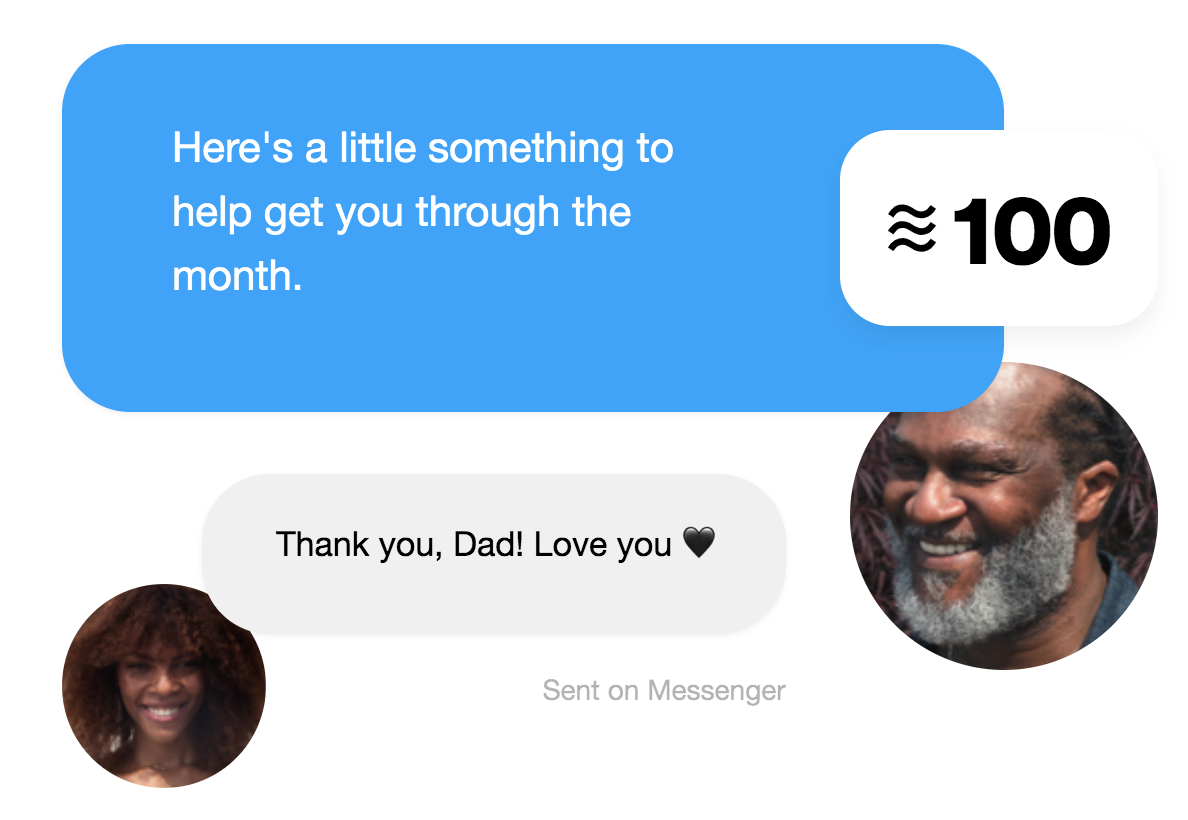
Christian Catalini of Facebook: Cryptocurrencies are taxed right now every time you have a sale on the differences in gains and losses. Because Libra is designed to be a medium of exchange, those gains and losses are likely to be very tiny relative to your local currency . . . Sales tax would likely be implemented the exact same way on Libra as it is today when you pay with a credit card.
At launch giving current regulations, the Calibra wallet will have to track every purchase and sale of Libra for a U.S. user and those differences will have to be reported on tax day. You can think of the losses, albeit they may be very small gains and losses relative to USD, as similar to the what people do today when they have a Coinbase account with Bitcoin.
The sales tax I think could be implemented in the exact same way as it today with any other sort of digital payment, it would be no different. If you’re buying goods or services with Libra you’ll be paying sales tax the same way as if you used a different form of payment. Like today when you see a percentage, that is the sales tax on your total.
Disparte: Maybe the best way to frame how taxes work all over the world is that it’s not up to Libra, Calibra, Facebook or any company to make that determination. It’s up to regulators and authorities.
TechCrunch: Does Calibra already have plans in place for how to handle sales tax?
Weil: That’s also a pretty rapidly evolving part of the regulatory ecosystem right now. It’s really an ongoing discussion. We will do whatever the regulation says we need to do.
TechCrunch’s Analysis: Here we have the firmest answers of our interviews. Facebook, Calibra and the Libra Association believe the proper approach to taxes is that Libra transactions carry a country’s traditional sales tax, and that Libra you hold in your wallet will have to pay taxes based on the Libra stablecoin’s value (that’s pegged to a basket of international currencies) relative to the U.S. dollar.
If the Libra Association recommends all wallets and transactions follow these rules and Calibra builds in protocols to handle these taxes simply, at least the government can’t argue Libra is a method of dodging taxes and everyone paying their fair share.
Powered by WPeMatico
Sage Plus for Experts gives travel experts a central place to share their content
Sage is giving reviewers, chefs and other experts and publishers a central place to share all their content.
To do this, the startup has created a new product called Sage Plus for Experts, which isn’t open to the public yet, but is accepting signups from those aforementioned travel experts — the kinds of experts who can share content around things to do, food, drinks, experiences and shopping.
Founder and CEO Samir Arora (who previously led Mode Media/Glam Media) suggested that a Sage profile can serve as the center of a creator or publisher’s online presence. And eventually, it could become the foundation for them to build their own personal direct-to-consumer brand.
In the announcement, Arora said the product was designed to answer a simple question: “Why does the internet not offer a simple way to show recommendations by real experts or the authentic experiences and products by the brands we trust and love?”

Back in 2017, when he first told me about his vision for Sage, Arora said his goal was to create a reliable source for location data. In an interview earlier this month, he said the plan to focus on verified sources eventually led him to this new product.
“We started to say that the only way to have verified information is to go backwards, to verify the sources of information — the journalists,” he said.
To do that, Sage starting curating a list of trusted experts, and it started working with those experts, who Arora said were asking for something like this. He showed me how someone could come onto the Sage service and quickly connect their social media accounts and author pages —after that, the profile updates automatically.
So there’s no technical expertise required, and after the initial setup, no additional work — though if they want to, experts can also post reviews and lists made specifically for Sage. They can even publish their Sage profile as a separate mobile app, and start monetizing through things like bookings and merchandise sales.

In some cases, the profile will already exist, and the expert simply needs to claim it.
“We’ve been manually curating sources while training an AI to reliably go out into the world to find people who are professionally in this business,” Arora said.
He added that Sage’s list has already grown to 5 million experts, with 200,000 active profiles. The active experts include food critic Masuhiro Yamamoto (whom you may know from “Jiro Dreams of Sushi”).
Ultimately, all expert content goes back into the broader Sage platform, and it will allow the startup to recommend trustworthy publishers and provide travel recommendations on what to do and where to go.
Powered by WPeMatico
Ford and Volkswagen team up on EVs, with Ford the first outside automaker to use VW’s MEB platform
Automakers Ford and Volkswagen have announced a partnership today that covers a number of areas, including autonomy (via a new investment by VW in Argo AI) and collaboration on development of electric vehicles. This EV tie-up will see Ford use Volkswagen’s MEB platform, which it’s using as the core of its forthcoming line of consumer electric vehicles, to develop “at least one” fully electric car for the European market that’s designed to be produced and sold at scale.
Volkswagen’s MEB is a big bet by the German automaker, meant to provide for all-electric models what the MQB platform before it did for the automaker’s internal combustion engine cars. The idea behind these platforms is that they are modular and flexible enough to cover a range of different vehicle types, while ensuring that there’s enough of a repeatable core that the cost of redevelopment from model to model is greatly decreased.
The MEB platform is already planned for use across a number of announced vehicles to be released by VW and VW-group automakers, including Audi, SEAT, Skoda and more between 2019 and 2023. Ford will be the first announced automaker outside of the Volkswagen Group to make use of the MEB. The automakers specify that there are only concrete plans for one model at the moment, but the option to expand that to more pending how that initial collaboration goes is baked into the deal.
Ford also plans to deliver more than 600,000 cars for the European market based on the MEB architecture over the course of six years for the first model alone, and the automakers note in a press release that there are considerations for a second Ford model to be developed based on the platform. Ford says in the release that this is just part of its overall, ongoing commitment to EVs, and that its work on crossover and other imported U.S. market models, including Mustang and Explorer, for Europe will continue. Both automakers will also remain independently and separately owned.
The general details of a partnership between the two automakers was reported as in the works by Reuters earlier this month, but is now confirmed as official by both automakers. VW also previously announced that German startup e.Go would be developing a vehicle based on the MEB, but details of that plan are not known and Ford is the first company that actually makes and delivers automobiles to make use of the Volkswagen Group tech in a model with concrete release timing and scale production intent.
Powered by WPeMatico


